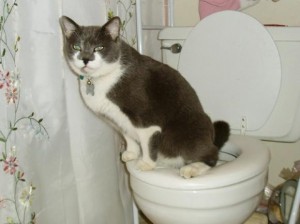Avoid Flush Cat Poop Down Your Toilet - Protect Your Plumbing Infrastructure
Avoid Flush Cat Poop Down Your Toilet - Protect Your Plumbing Infrastructure
Blog Article
Listed here in the next paragraph you will discover a bunch of very good help and advice related to Can You Flush Cat Poo or Litter Down the Toilet?.

Intro
As cat owners, it's important to bear in mind just how we dispose of our feline friends' waste. While it might appear practical to purge pet cat poop down the bathroom, this practice can have destructive repercussions for both the environment and human wellness.
Environmental Impact
Purging feline poop presents damaging pathogens and parasites right into the supply of water, positioning a substantial danger to water ecosystems. These pollutants can adversely impact marine life and compromise water top quality.
Health and wellness Risks
In addition to environmental worries, flushing cat waste can also posture health dangers to humans. Pet cat feces might contain Toxoplasma gondii, a parasite that can create toxoplasmosis-- a potentially extreme disease, specifically for pregnant women and individuals with weakened immune systems.
Alternatives to Flushing
The good news is, there are safer and a lot more liable ways to throw away pet cat poop. Take into consideration the following alternatives:
1. Scoop and Dispose in Trash
One of the most typical method of getting rid of feline poop is to scoop it right into a biodegradable bag and toss it in the garbage. Make sure to use a committed litter scoop and deal with the waste quickly.
2. Usage Biodegradable Litter
Select eco-friendly pet cat trash made from materials such as corn or wheat. These trashes are environmentally friendly and can be securely gotten rid of in the garbage.
3. Hide in the Yard
If you have a yard, think about hiding pet cat waste in a designated location far from veggie gardens and water resources. Be sure to dig deep sufficient to prevent contamination of groundwater.
4. Set Up a Pet Waste Disposal System
Buy a family pet garbage disposal system specifically designed for pet cat waste. These systems use enzymes to break down the waste, decreasing smell and ecological effect.
Conclusion
Liable pet dog ownership extends beyond giving food and shelter-- it likewise involves proper waste administration. By avoiding flushing feline poop down the commode and choosing alternate disposal methods, we can lessen our ecological footprint and secure human health.
Why Can’t I Flush Cat Poop?
It Spreads a Parasite
Cats are frequently infected with a parasite called toxoplasma gondii. The parasite causes an infection called toxoplasmosis. It is usually harmless to cats. The parasite only uses cat poop as a host for its eggs. Otherwise, the cat’s immune system usually keeps the infection at low enough levels to maintain its own health. But it does not stop the develop of eggs. These eggs are tiny and surprisingly tough. They may survive for a year before they begin to grow. But that’s the problem.
Our wastewater system is not designed to deal with toxoplasmosis eggs. Instead, most eggs will flush from your toilet into sewers and wastewater management plants. After the sewage is treated for many other harmful things in it, it is typically released into local rivers, lakes, or oceans. Here, the toxoplasmosis eggs can find new hosts, including starfish, crabs, otters, and many other wildlife. For many, this is a significant risk to their health. Toxoplasmosis can also end up infecting water sources that are important for agriculture, which means our deer, pigs, and sheep can get infected too.
Is There Risk to Humans?
There can be a risk to human life from flushing cat poop down the toilet. If you do so, the parasites from your cat’s poop can end up in shellfish, game animals, or livestock. If this meat is then served raw or undercooked, the people who eat it can get sick.
In fact, according to the CDC, 40 million people in the United States are infected with toxoplasma gondii. They get it from exposure to infected seafood, or from some kind of cat poop contamination, like drinking from a stream that is contaminated or touching anything that has come into contact with cat poop. That includes just cleaning a cat litter box.
Most people who get infected with these parasites will not develop any symptoms. However, for pregnant women or for those with compromised immune systems, the parasite can cause severe health problems.
How to Handle Cat Poop
The best way to handle cat poop is actually to clean the box more often. The eggs that the parasite sheds will not become active until one to five days after the cat poops. That means that if you clean daily, you’re much less likely to come into direct contact with infectious eggs.
That said, always dispose of cat poop in the garbage and not down the toilet. Wash your hands before and after you clean the litter box, and bring the bag of poop right outside to your garbage bins.
https://trenchlesssolutionsusa.com/why-cant-i-flush-cat-poop/

We were made aware of that article about How to Dispose of Cat Poop and Litter Without Plastic Bags through someone on a different blog. Liked our blog entry? Please share it. Help other people find it. Kudos for your time. Visit us again soon.
Go Deal Report this page